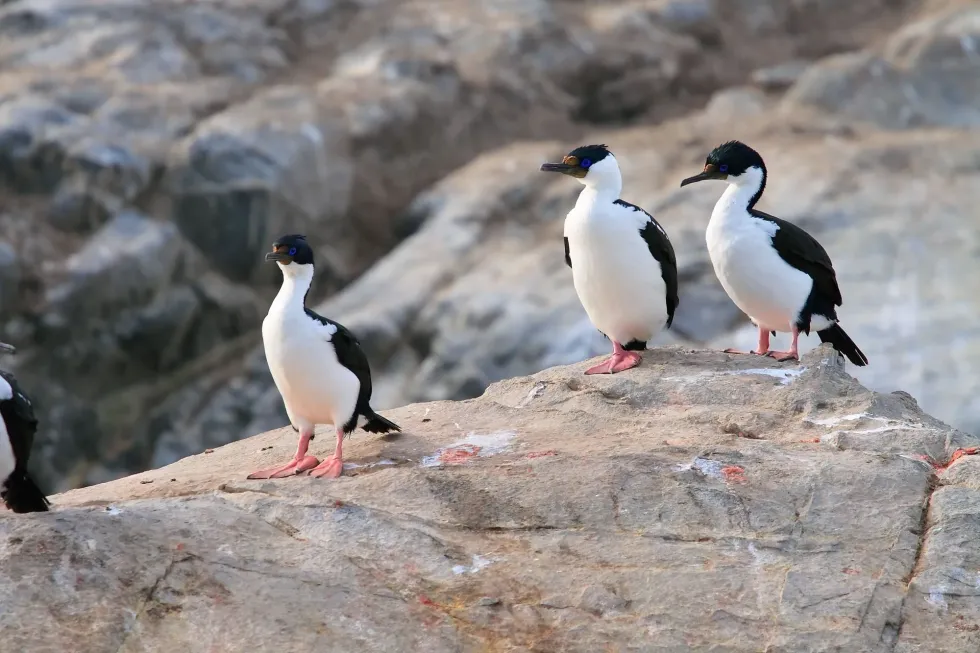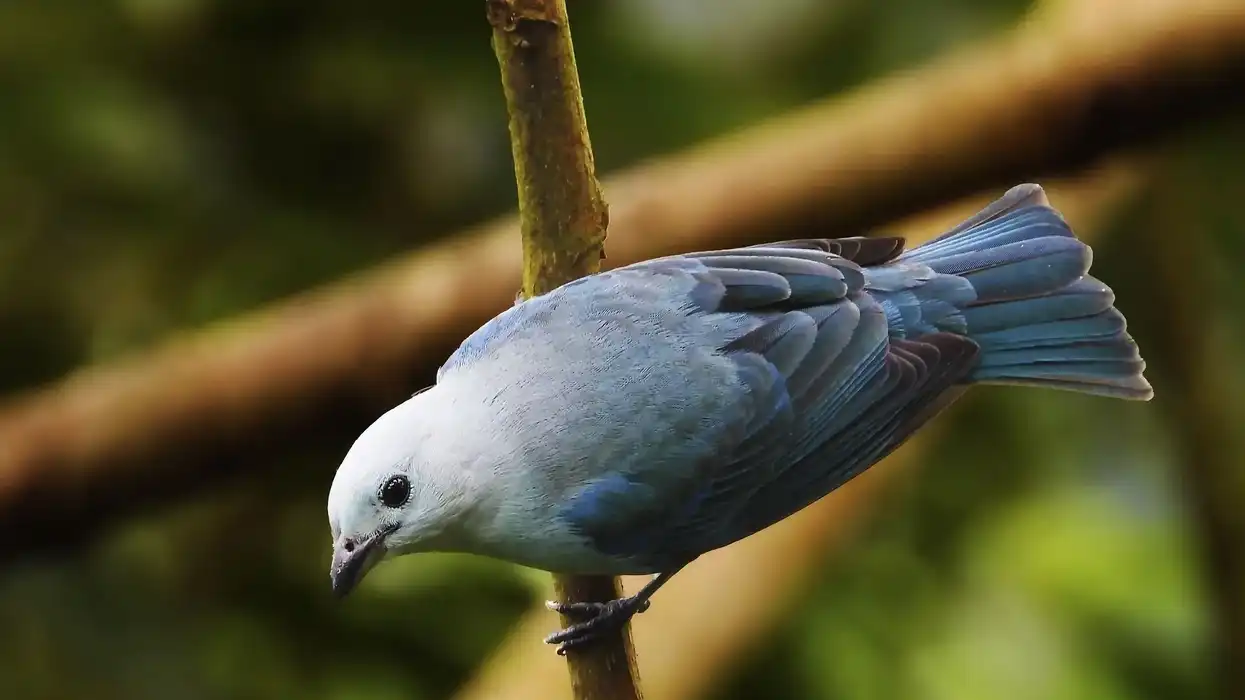Do you like cormorant birds, like the Neotropic cormorant? Then here we have all the information on the imperial cormorant.
The imperial cormorant, or also known as the imperial shag or blue-eyed shag, is a large bird that belongs to the Phalacrocoracidae family. The imperial shag (Phalacrocorax atriceps) lives in South Georgia, Argentina, Chile, and in more places in South America. They are also found in parts of Antarctica.
They have a black and white body, pink webbed feet, blue eyes, dark brown bill, and a yellowish-orange nasal knob. The breeding season occurs around October-November. During the breeding season, every bird builds its nest in colonies about 9.8-65.6 ft (3-20 m) away from the high tide line.
The nest is made of feathers, shells, sticks, and aquatic algae. These birds feed on fish, snails, squids, sea slugs, algae, and more.
Read on to know more about the blue-eyed shags and for more relatable content, check out these fun facts on the cockatoo and blue jay.
Blue-Eyed Shag Interesting Facts
What type of animal is a blue-eyed shag?
The imperial shag (Phalacrocorax atriceps) is a species of bird.
What class of animal does a blue-eyed shag belong to?
The imperial shag (Phalacrocorax atriceps) belongs to the class Aves of animals.
How many blue-eyed shags are there in the world?
The population of the imperial cormorant in exact numbers is not known. The eight sub-species of these birds have a population trend that's hard to follow as in some areas; it seems to be increasing. In some, it's decreasing, and in others, it's stable.
Where does a blue-eyed shag live?
Blue-eyed shags are not endemic. All the sub-species of the birds live across South America and in parts of Antarctica. To the west, they can be found as far as the sub-antarctic convergence.
To the north, they are seen until South Georgia and the Pacific Coast. They can also be seen in the Fuegian Mountains in Chile and the Antarctic peninsula. They are also migrating birds, but they are not known to travel far away from the South American and Antarctic border.
What is a blue-eyed shag's habitat?
Blue-eyed shags are known to live in grasslands and savannas in places with temperatures around 73.4°F (23°C). They prefer to live in places that have no shrubs or bare rocks in order to be able to see approaching predators at all times.
Who does blue-eyed shag live with?
Imperial cormorants are monogamous in nature and live in familial structures with their young. These families then make up colonies.
How long does a blue-eyed shag live?
The imperial shag is known to live for about 10-15 years.
How do they reproduce?
The breeding season for blue-eyed shags occurs around early October to late November. Not much is known about the courtship behavior of the species.
Both males and females mature sexually at the age of three years old. These birds mate for life, and selecting a mate is an arduous process for them.
After copulation, the females lay about three to five eggs on average in the nest. The incubation period for the eggs is about 28-31 days. Both the parents look after the hatchlings with no specific work roles for each of them.
From the time the females lay eggs to the age of 15-20 days, at least one parent stays with the young ones in the nest, protecting them. According to a study done, the fledging of the chicks happens at around 21-65 days.
What is their conservation status?
The conservation status of the imperial shag, according to the International Union for Conservation of Nature, is of Least Concern. There is no large threat to the species in general.
However, all the sub-species are affected in minor ways due to fishery, predators, and disturbances created by tourist boats. Some actions are being taken for the better preservation of the birds.
Blue-Eyed Shag Fun Facts
What does blue-eyed shag look like?

Imperial cormorants are large birds. As the name suggests, they have blue eyes. Their breasts are white, and their cheeks are white and black. Their bill is dark brown in color.
They have a yellowish-orange nasal knob. They have webbed feet, and these feet are pink in color. The dorsal side of the birds is glossy black, and the ventral side is white in color. The males of the species tend to be larger than females.
How cute are they?
Blue-eyed shags have somewhat of a penguin-like appearance, so they can be considered pretty cute to many people. However, they do display aggressive behavior towards birds of their own species and others on many occasions.
How do they communicate?
Not much is known about how the imperial shag (Phalacrocorax atriceps) communicates. Similar behavior can be seen in a closely related species, European shags of the same genus, Leucocarbo.
The males can vocalize that sound like honks, while females are only known to be able to hiss. As these two species are closely related, we can assume the blue-eyed shags act the same way as well.
How big is a blue-eyed shag?
Blue-eyed shags are about 26.4-31.2 in (67.1-79.2 cm) in size. They have a wingspan of 10.6-12.5 in (26.9-31.7 cm). The imperial cormorant is slightly smaller in size than the great cormorant. Great cormorants are about 27.6-40.2 in (70-102 cm) in size.
How fast can a blue-eyed shag fly?
These birds are inactive most of the time. However, they are migrating birds, so they have the ability to fly far and for long. They can reach a speed of up to 49.7 mph (80 kph).
How much does a blue-eyed shag weigh?
Blue-eyed shags are large birds that weigh about 3.5-5.6 lb (1.6-2.5 kg).
What are the male and female names of the species?
Males of the species are known as cocks, and females of the species are known as hens.
What would you call a baby blue-eyed shag?
Blue-eyed shag babies are known as chicks or hatchlings.
What do they eat?
Imperial cormorants are omnivorous in nature. They are known to feed on squids, sea slugs, scallops, snails, and sandworms. According to research done on these birds, objects like algae, stone, and fish were also found in their stomach contents.
Are they dangerous?
Blue-eyed shags are not known to pose any danger to humans. Their aggressive nature has only been observed towards birds of their own and other species and not towards humans. However, if threatened, they might attack humans as well.
Would they make a good pet?
Blue-eyed shags are wild animals. There have been no records of these birds living as pets. They require specific habitat conditions to survive. Taking them away from their natural habitat will only harm them.
Did you know...
A blue ring around the eye can only be seen in mature adult blue-eyed shags, and it becomes prominent mainly around the breeding season.
The imperial shag (Phalacrocorax atriceps) loves to dive. These birds hunt for fish and other aquatic animals in a flock, and they have the ability to dive at least 82 ft (25 m) to a maximum of 197 ft (60 m) into the water.
Do imperial shags live in Antarctica?
Yes, other than South America, blue-eyed shags also live in the sub-Antarctic convergence and can be seen in the Antarctic peninsula.
Is a shag a penguin?
A shag is not a penguin. They are different from penguins in many ways.
Here at Kidadl, we have carefully created lots of interesting family-friendly animal facts for everyone to discover! For more relatable content, check out these mealy parrot facts and Kea parrot facts for kids.
You can even occupy yourself at home by coloring in one of our free printable Talavera bluebird tile coloring pages.









